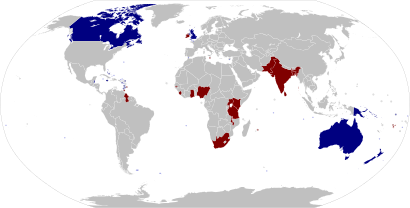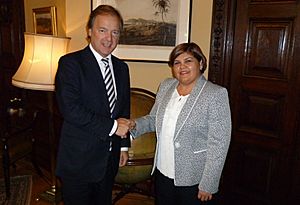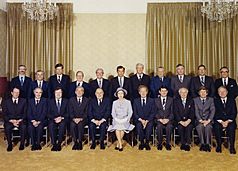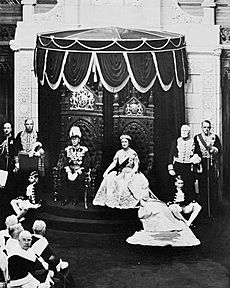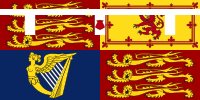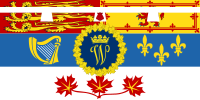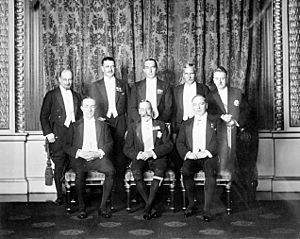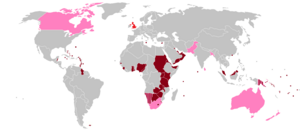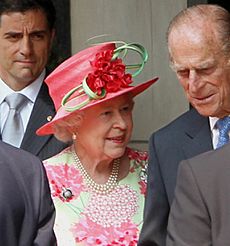Commonwealth realm facts for kids
A Commonwealth realm is a country that is part of the Commonwealth of Nations and has the same monarch (King Charles III) as the United Kingdom. Even though they share a monarch, each realm is an independent country. They are all equal to each other and to other nations in the Commonwealth. King Charles III became the monarch of these realms on September 8, 2022, after his mother, Elizabeth II, passed away.
When Queen Elizabeth II became monarch in 1952, she was the head of seven independent countries. These were the United Kingdom, Canada, Australia, New Zealand, South Africa, Pakistan, and Ceylon. Since then, more realms have become independent, and some have chosen to become republics (countries with a president instead of a monarch). Barbados was the most recent country to become a republic on November 30, 2021.
Today, there are 15 Commonwealth realms. They are Antigua and Barbuda, Australia, The Bahamas, Belize, Canada, Grenada, Jamaica, New Zealand, Papua New Guinea, Saint Kitts and Nevis, Saint Lucia, Saint Vincent and the Grenadines, Solomon Islands, Tuvalu, and the United Kingdom. All of these countries are members of the Commonwealth, which is a group of 56 independent nations. Most of these nations used to be part of the British Empire. All Commonwealth members are independent, whether they are realms or not.
Contents
What are the Current Commonwealth Realms?
There are 15 Commonwealth realms today. They are located across three continents: nine in North America, five in Oceania, and one in Europe. Together, they cover a huge area of about 18.7 million square kilometers (7.2 million square miles). Their total population is around 151 million people. Most of these people (about 148.5 million) live in the six largest realms: the United Kingdom, Canada, Australia, Papua New Guinea, New Zealand, and Jamaica.
How are the Realms Connected?
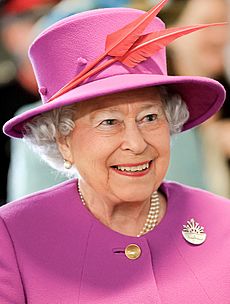
Commonwealth realms are independent countries. Their only shared connection is having the same monarch and following the same rules for who becomes monarch next. In 1936, it was said that the monarch was the "most important link" between these countries. This group of countries, connected in this way, is quite unique in the world. People have used terms like "personal union" or "shared monarchy" to describe it, but there's no single perfect term.
In 1926, a statement called the Balfour Declaration of 1926 said that these countries were "equal in status." This meant they were not controlled by the United Kingdom in their own affairs or foreign policy. They were united by their loyalty to the Crown. The monarch is officially the monarch of each separate country. For example, Elizabeth II was Queen of Canada, Australia, and New Zealand, not just Queen of Great Britain.
Because each realm has the same person as its monarch, they don't send ambassadors to each other like other countries do. Instead, they exchange "high commissioners." These officials act as links between the governments of the Commonwealth realms.
Sometimes, there can be disagreements between realms. For example, the monarch might give advice to one country's government that is different from what another country's government wants. More serious issues could happen if two realms were at war with each other, meaning the monarch would be head of state for both sides.
The Crown in the Commonwealth Realms
The idea of "the Crown" has changed over time. It now means that the monarch is equally the head of each country. The monarch acts on the advice of the government of that specific country. So, the term "Crown" can mean the overall institution connecting all 15 countries, or it can mean the Crown within each country separately. The monarchy is no longer just a British thing; it has become a part of each realm's own identity.
You can see the monarch's name and image on coins and banknotes in some countries. Also, politicians, judges, military members, and new citizens usually have to promise loyalty to the King. By 1959, officials said that the Queen felt "equally at home in all her realms."
Royal Succession and Regency
To make sure all realms share the same monarch, there's an agreement. If any country wants to change the rules for who becomes monarch next, all the other realms must agree. This rule was first used in 1936 when King Edward VIII wanted to give up his throne. All the countries had to agree to this change.
In 2011, all 16 realms at the time agreed to change the succession rules. They decided that the oldest child, regardless of gender, would inherit the throne. They also removed the rule that the monarch could not marry a Catholic. These changes became law on March 26, 2015.
However, a Commonwealth realm can choose to stop being a realm. It can do this by picking a different royal family or by becoming a republic. In these cases, the rule about all realms agreeing to succession changes does not apply.
Sometimes, the laws about succession can be different. For example, when Edward VIII gave up his throne in 1936, some countries passed their own laws. This showed that the Crown could be seen as separate in different countries.
Today, some realms have their own laws about who inherits the throne. Others simply say that whoever is the monarch of the United Kingdom is also their monarch. It's generally agreed that if the UK changes its succession rules on its own, it wouldn't automatically apply to all other realms.
If a monarch is too young or unable to rule, a "regent" can rule in their place. The United Kingdom has laws for this. Other realms decided that their governor-general could act for the monarch if needed, instead of being bound by the UK's laws.
Monarch's Role in the Realms
The monarch usually lives in the United Kingdom. In the other realms, the King appoints special representatives called viceroys to do most of his duties.
- In each realm, a governor-general acts as the King's personal representative.
- In Australia, there are also governors for each state.
- In Canada, there are lieutenant governors for each province.
These representatives are chosen based on the advice of the prime minister of that country or the premier of that state. The King might visit a realm to perform important duties himself, like signing a law or making a royal announcement. Otherwise, the viceroy carries out all the King's powers.
The monarch also performs ceremonial duties in the realms for important events. People in Commonwealth realms can even ask the King to send birthday or wedding anniversary messages. These are usually for very special milestones, like 100th birthdays or 60th wedding anniversaries.
Religious Role of the Monarch
The King has a special role in the Church of England, where he is the Supreme Governor of the Church of England. He also promises to protect the Church of Scotland. However, in other Commonwealth realms, the King does not have a formal role in organized religion.
Royal Flags
The Queen used different royal flags to show where she was or which realm she was representing. Each flag showed the shield from her coat of arms for that specific country. If she didn't have a special flag for a realm, she used her own personal flag. Some other members of the royal family also have their own flags for different realms, especially for Canada.
The governor-generals in each realm also have their own personal flags. These flags usually show a lion and a crown on a blue background, with the country's name. Canada and New Zealand have slightly different designs for their governor-general flags. The governors of Australian states and lieutenant governors of Canadian provinces also have their own flags.
How Commonwealth Realms Developed
Dominions Emerge
The idea of a colony becoming a new kingdom first came up in the 1860s. It was suggested that Canadian territories could unite and be called the Kingdom of Canada.
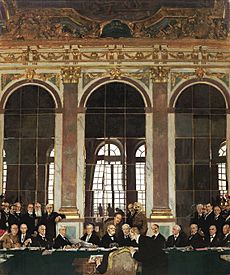
At first, these self-governing colonies, called "dominions," were still under British authority, especially for foreign policy and defense. Some people believed the Crown was one single thing across the whole empire. However, this idea started to change after the First World War. The dominions had helped a lot in the war, and they wanted more international recognition.
In 1919, leaders from Canada and South Africa demanded that the dominions be seen as "autonomous nations" at the peace conference. As a result, the dominions signed the Treaty of Versailles separately, even though the King signed for the whole Empire. They also became founding members of the League of Nations. By 1921, the British Prime Minister said that the "British Dominions have now been accepted fully into the community of nations."
Becoming More Independent
Balfour Declaration
The move towards independence sped up in the 1920s. Canada, for example, started exchanging diplomats with the United States in 1920. In 1922, Canada insisted that its parliament would decide its actions, not the British government. By 1925, the dominions felt strong enough to refuse to be bound by Britain's agreements.
A big change happened in 1926. The Governor General of Canada, Lord Byng, refused advice from his prime minister. This led to the Balfour Declaration of 1926. This declaration formally stated that the dominions were fully independent and equal to the United Kingdom.
This meant that the dominion governments had an equal standing with the UK. They also had a direct relationship with the monarch, without the British government in between. The governors-general now acted only as the monarch's personal representative in that dominion. In 1927, a law was passed that recognized the King as king of each dominion separately, not just the British king in each dominion.
Statute of Westminster
These new ideas were officially put into law in 1931 with the Statute of Westminster 1931. This law gave Canada, South Africa, and the Irish Free State full legislative independence from the UK right away. Australia and New Zealand adopted the law later. This meant that the British parliament could not make laws for any dominion unless the dominion asked them to.
The Statute of Westminster also made it clear that no changes could be made to the royal succession rules without all the realms agreeing. This was seen as an agreement among the Commonwealth countries to share the monarchy under the same rules.
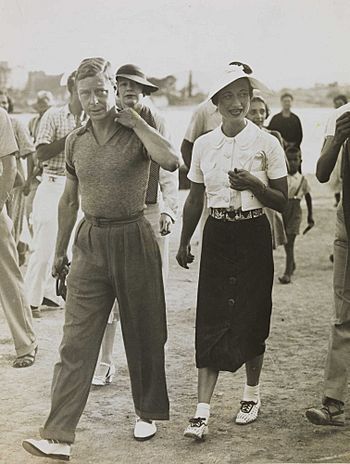
The first big test of this came in 1936 when King Edward VIII decided to give up his throne. All the dominion governments had to agree to his abdication before it could happen across the Commonwealth.
Fully Sovereign Dominions
In 1939, King George VI made a royal tour of Canada. This was important because he acted solely as the Canadian monarch during the trip. This showed that the King was truly the monarch of Canada, not just the British King visiting Canada.
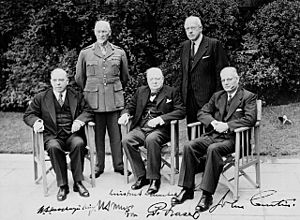
When World War II began, there was some confusion. Australia and New Zealand had not yet fully adopted the Statute of Westminster. However, Canada and South Africa made their own separate declarations of war against Germany, a few days after the UK did. This showed that they were independent in deciding whether to go to war. By the end of the war, it was clear that the King, as far as Canada was concerned, had to act only on the advice of Canadian ministers.
After the War
After World War II, India, Pakistan, and Ceylon became independent dominions. India soon decided to become a republic. However, India still wanted to be part of the Commonwealth. This led to the London Declaration in 1949, which allowed republics to be members of the Commonwealth. They just had to recognize the King as the "Head of the Commonwealth." Pakistan became a republic in 1956.
During this time, the term "dominion" was replaced with "Commonwealth country." This was to show that these countries were not less important than the United Kingdom.
From Queen Elizabeth II's Accession
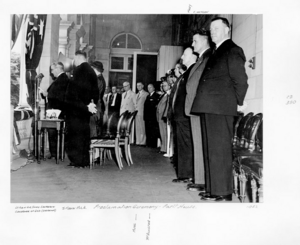
When Queen Elizabeth II became monarch, the prime ministers of the Commonwealth countries discussed her title. They wanted a title that would show she was Queen of Canada, for example, no matter her role in other countries. So, new laws were passed in each of the seven realms at the time. These laws formally recognized that each country was separate and equal. They changed the old phrase "British Dominions Beyond the Seas" to "His Other Realms and Territories."
At her coronation, Queen Elizabeth II promised to govern each realm separately. This showed that the Crown was not just British, but belonged equally to all her realms.
In 2010, Queen Elizabeth II spoke to the United Nations as queen of all 16 Commonwealth realms. In 2011, the Perth Agreement was made. This agreement meant that all the realms worked together to change the rules for who would inherit the throne, making sure the order stayed the same in every country.
Former Realms
Many countries that were once Commonwealth realms have since become republics. This means they now have a president as their head of state instead of the monarch.
List of Former States
| Country | From | To | How they changed | Royal Standard | Coat of Arms |
|---|---|---|---|---|---|
| 30 November 1966 | 30 November 2021 | Changed their constitution |  |
 |
|
| 4 February 1948 | 22 May 1972 | Adopted a new constitution |  |
||
| 10 October 1970 | 6 October 1987 | Military coup |  |
||
| 18 February 1965 | 24 April 1970 | Referendum and new constitution |  |
||
| 6 March 1957 | 1 July 1960 | Referendum and new constitution |  |
||
| 26 May 1966 | 23 February 1970 | Resolution |  |
||
| 15 August 1947 | 26 January 1950 | Adopted a new constitution |  |
||
| 6 December 1922 | 18 April 1949 | Act of parliament |  |
||
| 12 December 1963 | 12 December 1964 | Constitutional change |  |
||
| 6 July 1964 | 6 July 1966 | New constitution |  |
||
| 21 September 1964 | 13 December 1974 | Constitutional change |  |
||
| 12 March 1968 | 12 March 1992 | Constitutional change |  |
||
| 1 October 1960 | 1 October 1963 | Constitutional change |  |
||
| 14 August 1947 | 23 March 1956 | Adopted a new constitution |  |
||
| 11 November 1965 | 2 March 1970 | New constitution |  |
||
| 27 April 1961 | 19 April 1971 | New constitution |  |
||
| 31 May 1910 | 31 May 1961 | Referendum and new constitution |  |
||
| 9 December 1961 | 9 December 1962 | New constitution |  |
||
| 31 August 1962 | 1 August 1976 | New constitution |  |
 |
|
| 9 October 1962 | 9 October 1963 | Constitutional change |  |
The Dominion of Newfoundland was also a dominion, but it lost that status in 1934. It never became a Commonwealth realm. Instead, it became a province of Canada in 1949.
Referendums to Become Republics
Six Commonwealth realms and Dominions have held votes (referendums) to decide if they should become republics. Out of eight referendums, three have been successful: in Ghana, South Africa, and a second one in The Gambia.
Referendums that failed to make the country a republic happened in Australia, twice in Tuvalu, and in Saint Vincent and the Grenadines. Australia has shown interest in holding another referendum.
In 2020, the main opposition party in Jamaica promised a referendum on becoming a republic if they won the election. However, the ruling party, which had also promised a referendum before, was re-elected.
Barbados became a republic on November 30, 2021, after being a Commonwealth realm for 55 years. This change happened through a vote in their Parliament. Some people in Barbados felt that a public referendum should have been held.
| Year | Country | Yes Votes | No Votes | Difference (%) | Became Republic? |
|---|---|---|---|---|---|
| 1960 | 1,008,740 (88.49%) | 131,145 (11.51%) | 77% | ||
| 1960 | 850,458 (52.29%) | 775,878 (47.71%) | 5% | ||
| 1965 | 61,563 (65.85%) | 31,921 (34.15%) | N/A | ||
| 1970 | 84,968 (70.45%) | 35,638 (29.55%) | 41% | ||
| 1986 | 121 (5.34%) | 2,144 (94.66%) | 89% | ||
| 1999 | 5,273,024 (45.13%) | 6,410,787 (54.87%) | 10% | ||
| 2008 | 679 (35.02%) | 1,260 (64.98%) | 30% | ||
| 2009 | 22,646 (43.71%) | 29,167 (55.29%) | 12% |
See Also
 In Spanish: Monarquía en la Mancomunidad de Naciones para niños
In Spanish: Monarquía en la Mancomunidad de Naciones para niños
- British Empire
- Commonwealth Family
- List of sovereign states headed by Elizabeth II
- Member states of the Commonwealth of Nations
- Union of the Crowns


